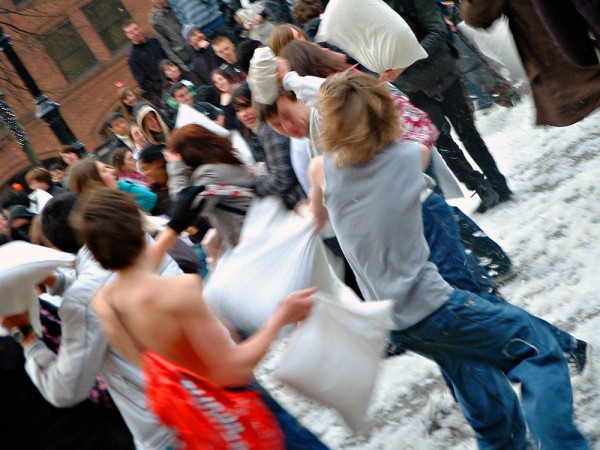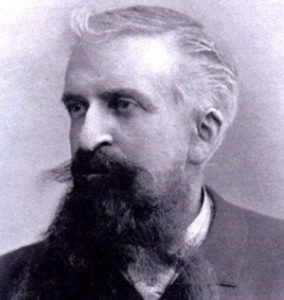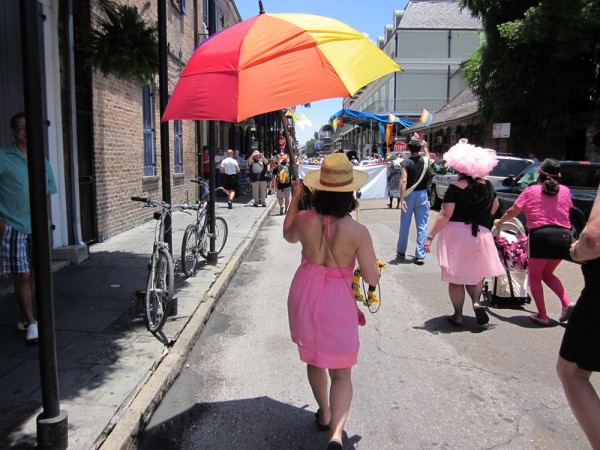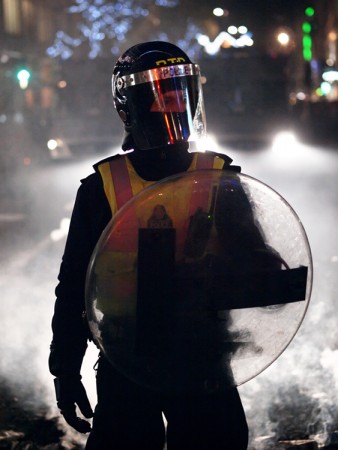18.1. Collective Behaviour
William Little and Ron McGivern
Flash Mobs

People sitting in a café in a touristy corner of Rome might expect the usual sights and sounds of a busy city. They might be more surprised when, as they sip their espressos, hundreds of young people start streaming into the picturesque square clutching pillows, and when someone gives a signal, they start pummeling each other in a massive free-for-all pillow fight. Spectators might lean forward, coffee forgotten, as feathers fly and more and more people join in. All around the square, others hang out of their windows or stop on the street, transfixed, to watch. After several minutes, the spectacle is over. With cheers and the occasional high-five, the crowd disperses, leaving only destroyed pillows and clouds of fluff in its wake.
This is a flash mob, a large group of people who gather together in a spontaneous activity that lasts a limited amount of time before returning to their regular routines. Technology plays a big role in the creation of a flash mob: select people are texted or emailed, and the message spreads virtually until a crowd has grown. But while technology might explain the “how” of flash mobs, it does not explain the “why.” Flash mobs often are captured on video and shared on the internet; frequently they go viral and become well known. So what leads people to want to flock somewhere for a massive pillow fight? Or for a choreographed dance? Or to freeze in place? Why is this appealing? In large part, it is as simple as the reason humans have bonded together around fires for storytelling, or danced together, or joined a community holiday celebration. Humans seek connections and shared experiences that break the moulds of daily routine. A flash mob, pillows included, provides a way to make that happen.
Flash mobs also illustrate the ways in which digital technologies and social media increasingly orchestrate contemporary social life. The darker side of public pillow fights and sponteneous choir performances is exemplified by the orchestrated protest and counter-protest over the purported “Islamization of Texas” in Houston Texas in 2016. The event was orchestrated remotely by Russian actors based in St. Petersburg (U.S. Select Committee on Intelligence, 2018). The U.S. Senate Intelligence Committee reported that the confrontation that drew dozens of individuals was organized as a Facebook event through two fake Facebook pages — The Heart of Texas and the United Muslims of America — operated by a Russian “Troll Factory” called the Internet Research Agency thousands of miles away.
Russia trolls were encouraging both sides to battle in the streets and create division between real Americans. Ironically, one person who attended stated, “The Heart of Texas promoted this event, but we didn’t see one of them.” We now know why. It’s hard to attend an event in Houston, Texas, when you’re trolling from a site in St. Petersburg, Russia. Establishing these two competing groups, paying for the ads, and causing this disruptive event in Houston cost Russia about $200 (U.S. Select Committee on Intelligence, 2018).
Again, it is important to ask what leads people to want to rally for an issue that has no basis in reality? Why is this appealing? What is the draw?
Forms of Collective Behaviour
Flash mobs are examples of collective behaviour, non-institutionalized activity in which several people voluntarily engage. Other examples of collective behaviour can include anything from a group of commuters traveling home from work to the trend toward adopting the Justin Bieber hair flip. In short, it can be any group behaviour that is not mandated or regulated by an institution. Four primary forms of collective behaviour include the crowd, the mass, the public, and social movements.
It takes a fairly large number of people in close proximity to form a crowd (Lofland, 1993). Examples include a group of people attending a Neil Young concert, attending Canada Day festivities, or joining a worship service. Turner and Killian (1993) identified four types of crowds. Casual crowds consist of people who are in the same place at the same time, but who are not really interacting, such as people milling around in a popular public square. Conventional crowds are those who come together for a scheduled event, like a religious service or a hockey game. Expressive crowds are people who join together to express emotion, often at funerals, weddings, or the like. The final type, acting crowds, focus on a specific goal or action, such as a protest movement or riot.
In addition to the different types of crowds, collective groups can also be identified in two other ways (Lofland, 1993). A mass is a relatively large and dispersed number of people with a common interest, but whose members are largely unknown to one another and who are incapable of acting together in a concerted way to achieve objectives. In this sense, the audience of the television show Bridgerton or of any mass medium (TV, radio, film, books) is a mass. A public, on the other hand, is an unorganized, relatively diffused group of people who engage with issues that are important for them. They are the basis of citizenry.
While these two types of group are similar, they are not the same. In his 1956 book, The Power Elite, Sociologist C. Wright Mills (1956) described the difference between a public and a mass based on their different forms of communication. In a public, communication is a conversation between equals where “virtually as many people express opinions as receive them” and “communications are so organised that there is a chance immediately and effectively to answer back to any opinion expressed in public” (Mills, 1956). People have the ability to “answer back.” This is the foundation of Habermas’ concept of a public sphere, the open “space” of public debate and deliberation in democratic societies where public opinion can be formed (See Chapter 17. Government and Politics). As Habermas puts it, “a portion of the public sphere comes into being in every conversation in which private individuals assemble to form a public body” (Habermas, 1974).
In a mass, communication tends to be one way and top down, like a broadcast that delivers a message to potentially millions of separate listeners, who are otherwise unconnected. As Mills describes, in a mass “far fewer people express opinions than receive them; for the community of publics becomes an abstracted collectivity of individuals who receive impressions from the mass media” (Mills, 1956). Communication is one way. There is little provision for individuals to answer back to the messages they receive, whereas a public can potentially translate its opinions into action. Sometimes this translation entails forming social movements.
Social movements (discussed in the next section) are purposeful, organized groups striving to work toward a common goal. These groups might be attempting to create change (Black Lives Matter, #Metoo, Idle No More), to resist change (Luddites, anti-globalization movement, fundamentalists, anti-vaxxers), or to provide a political voice to those otherwise disenfranchised (anti-poverty movements, Grandmothers to Grandmothers, Live Aid). Unlike the crowd, the mass and the public, social movements are understood as intentional and organized. They emerge and develop specific goals to create (or resist) social change.
Theoretical Perspectives on Collective Behaviour

Early collective behaviour theories (Blumer, 1969; Le Bon, 1895) focused on the irrationality of crowds. Gustave Le Bon saw the tendency for crowds to break into riots or, for example, anti-Semitic pogroms, as a product of the properties of crowds themselves: anonymity, contagion, and suggestibility. On their own, each individual would not be capable of acting in this manner, but as anonymous members of a crowd they were easily swept up in dynamics that carried them away. Crowds made ordinarily independent, rational thinking individuals susceptible to suggestion and irrational crowd behaviour.
Eventually, those theorists who viewed crowds as uncontrolled groups of irrational people were supplanted by theorists who viewed the behaviour of some crowds as the rational behaviour of logical beings.
Emergent-Norm Perspective

Sociologists Ralph Turner and Lewis Killian (1993) built on earlier sociological ideas and developed what is known as emergent norm theory. They believe that the norms experienced by people in a crowd may be disparate and fluctuating. They emphasize the importance of these norms in shaping crowd behaviour, especially those norms that shift quickly in response to changing external factors. Emergent norm theory asserts that, in this circumstance, people perceive and respond to the crowd situation with their particular (individual) set of norms, which may change as the crowd experience evolves. This focus on the individual component of interaction reflects a symbolic interactionist perspective.
For Turner and Killian, the process begins when individuals suddenly find themselves in a new situation, or when an existing situation suddenly becomes strange or unfamiliar. For example, think about human behaviour during Hurricane Katrina in 2005. New Orleans was decimated and people were trapped without supplies or a way to evacuate. In these extraordinary circumstances, what outsiders saw as “looting” was defined by those involved as seeking needed supplies for survival. Normally, individuals would not wade into a corner gas station and take canned goods without paying, but given that they were suddenly in a greatly changed situation, they established a norm that they felt was reasonable.
Once individuals find themselves in a situation ungoverned by previously established norms, they interact in small groups to develop new guidelines on how to behave. According to the emergent-norm perspective, crowds are not viewed as irrational, impulsive, uncontrolled groups. Instead, norms develop and are accepted as they fit the situation. While this theory offers insight into why norms develop, it leaves undefined the nature of norms, how they come to be accepted by the crowd, and how they spread through the crowd.
Value-Added Theory
Neil Smelser’s (1962) meticulous categorization of crowd behaviour, called value-added theory, is a perspective within the functionalist tradition based on the idea that several conditions must be in place for collective behaviour to occur. Each condition adds to the likelihood that collective behaviour will occur.
The first condition is structural conduciveness, which describes when people are collectively aware of a problem and have the opportunity to gather, ideally in an open area. Structural strain, the second condition, refers to people’s expectations about the situation at hand being unmet, causing tension and strain. The next condition is the growth and spread of a generalized belief, wherein a problem is clearly identified and attributed to a person or group. Fourth, precipitating factors spur collective behaviour; this often involves the emergence of a dramatic event. The fifth condition is mobilization for action, when leaders emerge to direct a crowd to action. The final condition relates to action by the agents of social control to suppress or disperse the crowd. Called social control, it is the only way to end a collective behaviour episode according to Smelser (1962).

A real-life example of these conditions occurred after the fatal police shooting of teenager Michael Brown, an unarmed eighteen-year-old African American, in Ferguson, MO on August 9, 2014. The shooting drew national attention almost immediately. A large group of mostly Black, local residents assembled in protest—a classic example of structural conduciveness. When the community perceived that the police were not acting in the people’s interest and were withholding the name of the officer, structural strain became evident. As the crowd of protesters were met with heavily armed police in military-style protective uniforms accompanied by an armored vehicle, a growing generalized belief evolved that the police would not properly investigate the shooting. The precipitating factor of the arrival of the police spurred greater collective behavior as the residents mobilized by assembling a parade down the street. Ultimately they were met with tear gas, pepper spray, and rubber bullets used by the police acting as agents of social control. The element of social control escalated over the following days until August 18, when the governor called in the National Guard.
While value-added theory addresses the complexity of collective behaviour, it also assumes that such behaviour is inherently negative or disruptive. In contrast, collective behaviour can be non-disruptive, such as when people flood to a place where a leader or public figure has died to express condolences or leave tokens of remembrance. People also forge temporary alliances with strangers in response to natural disasters. Some of the same principles apply, like structural conduciveness, growth and spread of a generalized belief, and mobilization for action, even when conflict and disruption is absent.
Assembling Perspective
Symbolic interactionist sociologist Clark McPhail (1991) developed the assembling perspective, another system for understanding collective behaviour that credited individuals in crowds with being rational agents. Unlike previous theories, this theory refocuses attention from collective behaviour to collective action. Whereas collective behaviour is a voluntary non-institutional or spontaneous gathering, collective action involves concerted behaviour based on a shared interest. A number of people come together to achieve some common objective. His theory focuses primarily on the processes associated with crowd behaviour, plus the life cycle of gatherings.
McPhail noted that the concept of crowd behaviour suggests a unanimity of motives and actions that empirical observation does not bear out. In temporary gatherings, an assembling process brings people into a common location and a dispersing process terminates the gathering, but in between what people do alone and in relation to others varies considerably. He and his students identified several different types of convergent or collective behaviour within gatherings, as shown on the chart below.
| Type of crowd | Description | Example |
|---|---|---|
| Convergence clusters | Family and friends who travel together | Carpooling parents take several children to the movies |
| Convergent orientation | Group all facing the same direction | A semi-circle around a stage |
| Collective vocalization | Sounds or noises made collectively | Screams on a roller coaster |
| Collective verbalization | Collective and simultaneous participation in a speech or song | Singing “O Canada” at a hockey game |
| Collective gesticulation | Using body parts to form symbols | The YMCA dance or the human wave. |
| Collective manipulation | Objects collectively moved around | Holding signs at a protest rally |
| Collective locomotion | Coordinating direction and speed of movement | Children running to an ice cream truck |
Also, contrary to the idea of the anonymous crowd, McPhail observed that typically most people in a gathering either arrive with, or have made arrangements to meet one or more acquaintances with whom they remain for the duration. Temporary gatherings are therefore assemblages composed of some singles and many small primary groups. This is significant for crowd behaviour because if members of a gathering know each other they also take responsibility for each other and exercise influence over each other.
As useful as this is for understanding the components of how crowds come together, many sociologists criticize its lack of attention on the large cultural context of the described behaviours, instead focusing on individual actions.
Media Attributions
- Figure 18.5 Flash Mob Pillow Fight by Mattw1s0n, via Flickr, is used under a CC BY 2.0 licence.
- Figure 18.6 Gustave Le Bon, c. 1900 by unknown photographer, via Wikimedia Commons, is in the public domain.
- Figure 18.7 Parade Pink Poodles Parasol by Infrogmation of New Orleans, via Flickr, is used under a CC BY 2.0 licence.
- Figure 18.8 London riot police, November 2010, by Eric Hossinger, via Flickr, is used under a CC BY 2.0 licence.

